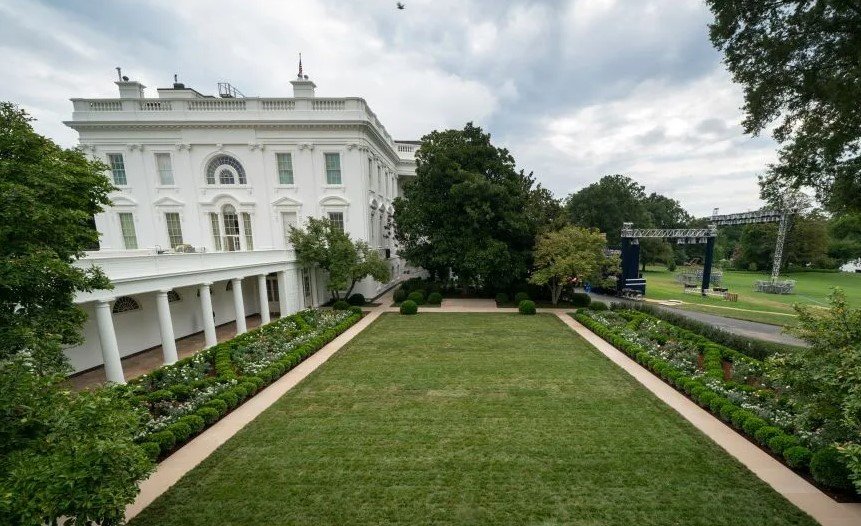President Donald Trump has completed a major overhaul of the White House Rose Garden, replacing its historic grass lawn with a stone patio that mirrors the style of his Mar-a-Lago resort in Florida. This $1.9 million project, finished in August 2025, aims to make the space more practical for events while drawing mixed reactions from the public and historians.
Project Background and Timeline
The idea for the renovation surfaced early in Trump’s second term, with reports emerging in February 2025 that he wanted to pave over the grass to create a hard surface similar to Mar-a-Lago’s outdoor areas. Work began in the summer, following approvals and planning that tied into broader White House updates.
By July 2025, construction was well underway, with crews removing the lawn that had been a key feature since Jackie Kennedy’s redesign in the 1960s. The project wrapped up ahead of schedule, with the new patio unveiled in early August. Trump has described the change as a practical fix for issues like wet grass during events.
This move fits into Trump’s pattern of personalizing government spaces, much like his first term’s updates to the Oval Office decor. Recent events, such as outdoor press briefings, highlighted the need for a more durable surface.
Key Changes in the Renovation
The core transformation involved swapping the green lawn for pale stone pavers, laid in a diagonal pattern to match the White House’s exterior. New drainage systems with star-and-stripe grates prevent water buildup, addressing Trump’s concerns about soggy ground.

Additions include white tables, chairs, and yellow-striped umbrellas, directly inspired by Mar-a-Lago’s setup. These elements create a resort-like vibe, making the space suitable for gatherings without the mess of mud or uneven terrain.
- Stone pavers: Light-colored to reflect heat and stay cool.
- Furniture: White sets with yellow umbrellas for shade and style.
- Drainage: Upgraded perimeter systems for better water flow.
The patio now spans about 2,500 square feet, turning the area into a versatile venue for speeches, receptions, and media events. Trump noted in interviews that the design helps women in high heels avoid sinking, a problem he observed during past ceremonies.
Overall, the changes blend functionality with Trump’s personal taste, echoing his Florida property’s luxurious outdoor spaces.
Public and Expert Reactions
Reactions to the makeover have been divided, with some praising the practicality while others lament the loss of history. Garden enthusiasts and historians argue that paving over the lawn erases a piece of American heritage tied to the Kennedy era.
Social media buzzed with opinions, from approval for the modern look to criticism labeling it as tacky or unnecessary. One common view is that it personalizes the White House too much, turning a public symbol into a private resort extension.
Environmental groups raised concerns about reducing green space in an urban setting, though the project retained many rose bushes and plants around the edges. Supporters point out that the update aligns with current needs, like hosting larger events amid rising temperatures in Washington, D.C.
In broader context, this renovation joins other 2025 White House tweaks, such as updated security features, showing Trump’s focus on blending legacy with innovation.
Cost Breakdown and Funding
The total cost came in at $1.9 million, funded through a mix of federal allocations and private donations tied to preservation efforts. This figure covers materials, labor, and design work, making it one of the pricier garden projects in recent history.
Here’s a simple table outlining the main expenses:
| Item | Estimated Cost | Details |
|---|---|---|
| Stone Pavers | $800,000 | High-quality material matching White House stone |
| Drainage Systems | $500,000 | Includes custom grates and installation |
| Furniture and Umbrellas | $200,000 | Imported styles from Mar-a-Lago suppliers |
| Labor and Design | $400,000 | Crews and architects over summer months |
Critics question if the spending was justified, especially with national priorities like infrastructure in focus this year. Defenders argue it enhances the White House’s role as a functional space for diplomacy and public engagement.
Compared to past renovations, this one is modest; for instance, a 2020 refresh under Trump cost less but focused on plants rather than hardscaping.
Historical Significance and Future Use
The Rose Garden has hosted countless key moments, from peace treaty signings to presidential addresses, since its 1913 origins. The grass lawn, a hallmark of Jackie Kennedy’s vision, symbolized openness and natural beauty in the heart of power.
Now, with the patio in place, the space could see more frequent use for evening events or casual meetings, reducing wear and tear. Trump has hinted at hosting fundraisers and international talks here, leveraging the Mar-a-Lago aesthetic to impress visitors.
Looking ahead, this change might influence how future presidents view White House grounds, balancing tradition with modern demands. As climate patterns shift, such adaptations could become more common in historic sites across the U.S.
What do you think about this renovation? Share your thoughts in the comments below or on social media, and spread the word if you found this breakdown helpful.
